
Promoting Cross-border
Communication in an International Web-based Graduate Course
John
LeBaron, University of Massachusetts Lowell
Jyrki Pulkkinen, University
of Oulu, Finland
Patrick Scollin, University
of Massachusetts Lowell
Abstract
The design and
distribution of cross-border higher education courses via global computer networks
is a rapidly growing phenomenon (Davis 1998). This paper describes two rounds
of an international graduate-level Web-based course in education. It presents
research that focuses on the challenge of international, cross-cultural graduate
course design in education. Using diverse methods of inquiry, successes and
failures of the effort to address cross-cultural concerns are reported. This
inquiry informs the work of teachers, researchers, course designers and program
developers seeking to expand instructional horizons through international academic
collaboration.
1. Introduction
From January
through May 1999, and again in 2000, a computer networked graduate course connected
education students from the University of Oulu in Finland with peers from the
University of Massachusetts Lowell in a shared, project-centered academic endeavor.
The course, Open & Flexible Learning (OFL), was offered in
English via the World Wide Web. It represented a joint initiative of the two
participating universities. (In 1999, a small number of students from Finland's
University of Jyväskylä also participated.)
Forty students were initially enrolled in OFL-1999: twenty-one Finnish and nineteen American. Students were defined as "active" course participants if they participated in any aspect of the course discussion, whether or not they completed the course assignments. By this definition, in 1999 nineteen Americans and thirteen Finns were deemed active. In 2000, the initial enrollments consisted of nine Finnish and five U.S. students. Of these, seven Finns and all five Americans were active.
![]() External
links to : Home
pages of the U Oulu Faculty of Education, UO
Ed Tech Research Unit, U
Mass Lowell Graduate School of Education
External
links to : Home
pages of the U Oulu Faculty of Education, UO
Ed Tech Research Unit, U
Mass Lowell Graduate School of Education
OFL addressed a broad
range of issues related to distance and distributed education in schooling and
in higher education. The technical platform for this course, called ProTo
in 1999 and Learning Community Profiler (LCP) in 2000, is the
product of research and development at the University of Oulu. OFL was
among the first electronically networked, academic courses formally cross-credited
between Finnish and American universities.
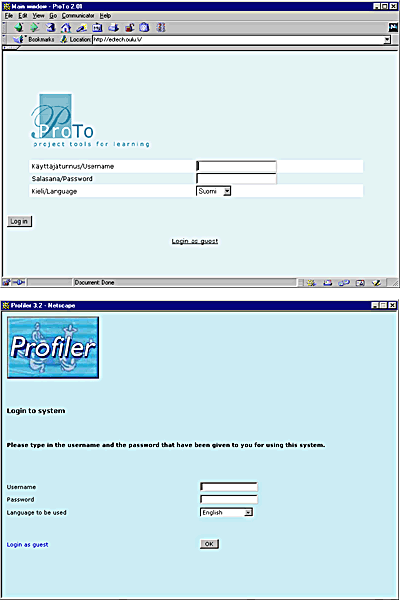
Figure 1. Screen shots
of course login "Welcome" screens of ProTo and for LCP
![]()
During the same time frame
in 2000, a second, somewhat altered online course was offered to Finnish and
American students on an upgraded course authoring-teaching platform. Based on
the lessons learned from OFL-1999, the instructor and tutors tried to
improve the environments in 2000. Based on evaluative data from both versions
of the course, these improvements are described below.
2. The Course: Open &
Flexible Learning
This course examined core
issues related to online open and flexible learning in global, computer-networked
environments. In addition, the course investigated other selected telecommunications
technologies used in the design and execution of distributed learning environments.
Students worked individually or in teams to analyze and critique contemporary
practices in this field. The instructor team was comprised of a lead professor
supported by several graduate student tutors who assisted either on the Finnish
or the American side, and highly skilled technical staff from UO. Since much
of the responsibility for such contact rested with the student, a high degree
of discipline and self-motivation was required for success. This is consistent
with several reports on student roles and responsibilities in online learning
settings (Charp 1994, in Sherry 1996).
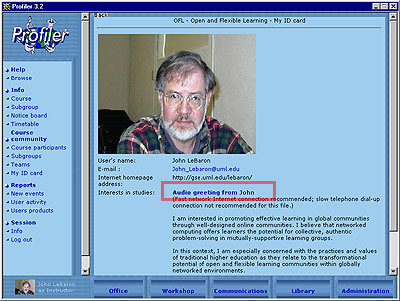
Figure 2. Course ID
card of for the supervising professor.
![]() Demo 1 Resources
linked from the course environment: Audio greeting
from John
Demo 1 Resources
linked from the course environment: Audio greeting
from John

Figure 3. The OFL
course design team. From left to right: Tarja Tervola (Tutor), Jyrki Pulkkinen
(Lead ProTo designer), Steven Tello (Tutor), Merja Ruotsalainen (Student),
John LeBaron (Course Instructor)
![]() Demo 2 Resources
linked from the course environment: An audio greeting
in Finnish about LC Prof from
Demo 2 Resources
linked from the course environment: An audio greeting
in Finnish about LC Prof from
Merja Ruotsalainen
Due to the asynchronous and "distant" nature of the course, students were urged to sustain regular communication with instructors, tutors and peers. They were also responsible for reviewing online or library-based course materials, and to reflect this research in all written communication. Threaded discussion forums offered a capacity for academically focused conversation among peers and between students and members of the instructional team. Students worked on thematic concentrations of their choice, but were expected to show mastery of the broader substantive context. In order to promote cross-border communication and awareness-building, two or three synchronous ISDN video conferences were conducted at critical points in the two course timetables.
![]() Demo 3 Resources
linked from the course environment: Streaming
video conference
Demo 3 Resources
linked from the course environment: Streaming
video conference
Within the course environment, an online "library" provided a collection of resources developed or selected by the instructors and tutors. This library was divided into five major categories. The first contained pointers to "core readings," which every student was required to examine critically at the earliest possible date. This reading provided common ground for subsequent peer communication. The next three library categories divided resources into the "cornerstone" content clusters described above (Pedagogy, Technology, Management & Social Organization.) The fifth category (General Resources & Information) provided glossaries and other reference tools. The library was rounded out with multimedia resources (e.g., streamed video, PowerPoint slides.)
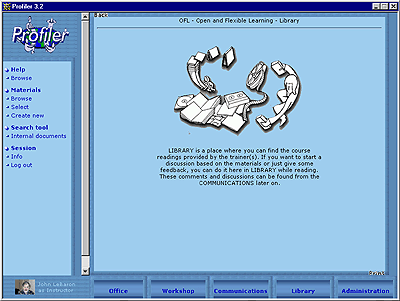
Figure 4. Course
Library screen level 1
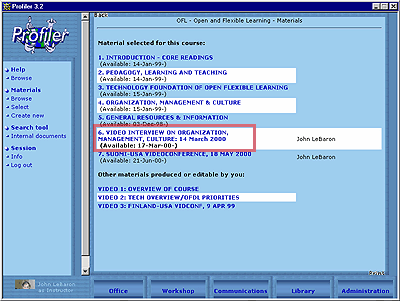
Figure 5. Course Library
screen level 2
![]() Demo 5 Resources
linked from the course environment: Streaming
video interview linked from the OFL-2000 Course Library
Demo 5 Resources
linked from the course environment: Streaming
video interview linked from the OFL-2000 Course Library
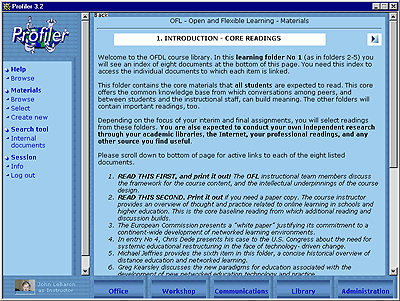
Figure 6. Course Library
screen level 3
![]()

Figure 7. screen shots
for discussion, cafe, notes, and timetable functions.
3. Characteristics of the
Technical Learning Environments
ProTo and its successor,
Learning Community Profiler, are easy-to-use learning environments that
contribute to modern open and flexible studying on the Web. Both provide comprehensive
communications and collaboration functions to enable the instructors and students
to work cooperatively toward meaningful learning goals.
ProTo and LCP both run on the Internet, or on local intranets, based on TCP/IP Web protocols. These tools store all information about the users and courses on a central database server. The students, instructors and administrators may access the server from anywhere on the network using a standard Web browser with commonly used plug-ins. ProTo and LCP enable bi-directional "real-time" and asynchronous communication. At the same time these applications also enable access to networked multimedia and hypermedia within their course environments.
The ProTo and LCP operating environments become an active part of the whole learning process and help shape learning community behavior. These platforms offer tools for learners to engage easily in structured learning, and enable teachers to create and organize open and flexible Web-based courses. The "cornerstones" of this open and flexible learning environment are threefold:
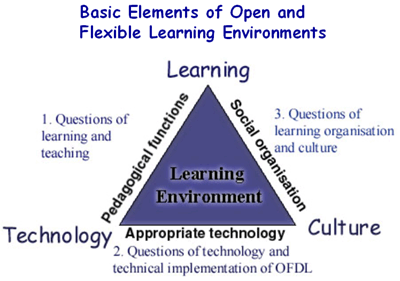
![]()
Figure 8. Constructivist
concept foundation
Thus, ProTo and LCP are based on constructivist learning principles that combine essential elements for open and flexible learning. Students are expected to construct their knowledge and skills through personal experiences and social interaction in the learning community.
4. The Research Agenda
A growing body of literature
addresses problems of international student collaboration in networked courses.
In a study addressing a distance learning collaboration involving one U.S. and
two African universities, Telg (1996) asserts that such cross-border ventures
require extensive planning and coordination among the participating faculty.
Moreover, Telg declares that cooperative distance education initiatives between
American and foreign universities are quite rare. The core theme of a recently
edited book by Mestenhauser & Ellingboe (1998) urges faculty in American
higher education to move swiftly across disciplines to infuse global components
into their curricula.
Jenkins (1997) discusses cross-cultural miscommunication between faculty and foreign international teaching assistants (ITAs) in a university mathematics department. Faculty members tended to attribute the reserved, deferential behavior of Chinese ITAs to uncooperative attitudes and poor motivation, whereas the ITAs suggested that their behavior stemmed from situational stress of working in a second language and unfamiliar host culture.
Murphy (1991) warns of disparities in student perception about success and failure in international distance learning environments. She suggests that courses simultaneously enrolling students from highly competitive western cultures and from more cooperative societies may produce widely divergent student expectations, not only from their instructors but also from their fellow students. Jager and Collis (2000) agree. In a paper offering guidelines for designers of cross-cultural Web-based learning environments, they write, "Designers and instructors should be aware of cultural differences, in what people do, how they teach, to what extent they accept different reactions from different people. For example, in some cultures, it is normal to criticize others. . . , in other cultures it is not" (p. 461).
In their study of cultural challenges in a European multinational setting for online learning, Pulkkinen and Ruotasalainen (2001) point out that cultural conflicts between the familiar comforts of traditional classroom pedagogy and the more independent demands of learning in open and flexible networked environments sometimes pose greater challenges than the cultural distinctions among nations. Reinforcing this sentiment, Jager and Collis (2000) affirm that cultural realities operate at multiple levels ranging from the broadly societal to the disciplinary and the uniquely personal.
![]() External
links to Betty Collis' web sites at the University of Twente, Netherlands on
: Cultural
realities
External
links to Betty Collis' web sites at the University of Twente, Netherlands on
: Cultural
realities
![]() External
links to McNabb paper on : standardized
assessment techniques
External
links to McNabb paper on : standardized
assessment techniques
![]() External
links to Wideman & Owston paper on on : Networked
versus non-networked environments
External
links to Wideman & Owston paper on on : Networked
versus non-networked environments
![]()
More current research has
examined the efficacy of efforts to build constructivist, international online
learning activities. As McNabb (1995) points out, standardized assessment techniques
often fail to measure key indicators of student success in open and flexible
learning situations. Rather than pursue standard research agendas that compare
predefined student outcomes in networked versus non-networked environments (Wideman
& Owston 1999), this report intends to evaluate efficacy in terms of the
intentions that drove the design of OFL in the first place.
5. Comparative Demographic and
Situational Realities among Finns and Americans
![]() Figure 9. Graphic
display of student demographics and situational circumstances
Figure 9. Graphic
display of student demographics and situational circumstances
In OFL-1999, twenty-six students completed the final course evaluation, eighteen from the USA (94.7% of active students) and eight from Finland (61.5%). (At this writing, it is too early to report the results of the OFL-2000 online student course evaluation.) In 1999, all 26 respondents (100%) reported having used e-mail prior to the course. Only one, an American, had never previously browsed the Web. Nineteen (73.1%) had never previously participated in an Internet based course. A majority of the Finns (five of eight) were experienced in the use of Internet-based learning environments. An overwhelming majority of Americans (sixteen of eighteen) were complete Internet online learning neophytes.
Conclusions from this report should be considered in light of cultural and educational differences between Finland and the U.S.A. Many would agree that Americans are more voluble than Finns. Finns take pride in their tendency not to talk unless they have something worthwhile to say. Commenting on American habits of communication, two Finns, Lehtonen and Sajavaara (1985, in Iivonen et al., 1998) remark that "Americans ask questions and force others to talk to fill up interactional silence, because silence is not tolerated socially" (p. 199).
![]() External
links to iivonen, Sonnenwald, Parma & Poole-Kober paper on: student
remarks
External
links to iivonen, Sonnenwald, Parma & Poole-Kober paper on: student
remarks
Higher education in Finland is tuition free. Although most courses are offered during fixed semesters, it is quite common for Finnish students to submit work for assessment long after the end of a semester without forfeit of money or credit. Performance of Finnish graduate work is assessed on a pass-fail basis. American students are typically awarded letter grades. When the student performance stakes vary so much between countries, unique challenges arise in designing tactics for international collaboration. For example, although only a few students from either country failed to complete the 1999 course in the prescribed time frame (two American and three Finnish), an additional eight formally enrolled Finns neither participated at all nor dropped the course. (Rather than "drop outs," we might call them "never ins".) In the U.S.A., this would be quite rare.
6. The Study
Since a
major aim of the course was to foster purposeful student collaboration across
national boundaries, this particular issue is addressed. The following data
sources support this paper:
![]() External
links to online student evaluation form : Link
to questionnaire
External
links to online student evaluation form : Link
to questionnaire
The final 1999 course evaluation consisted of fifty-seven questions distributed across the following categories: Background information, General overview of the course, Comparing online with traditional classroom courses, Instructional activities, Course interaction, and the ProTo environment.
Of the thirty-eight Likert scale questions posed, only the following five produced
significant variations in agreement between Finnish and American students:
![]() Figure 10. Graphic
display of disparities between Finnish and US student perceptions
Figure 10. Graphic
display of disparities between Finnish and US student perceptions
These disparities in perception pertain to issues of community and student success. Notwithstanding their relative lack of prior seasoning in online learning, the Americans seemed to come away from OFL-1999 with more positive reflections on their perceptions of community and success than did the Finns.
Even though the following four questions show little variation between Finnish and American views, they pose distinct general challenges for future course development:
![]()
![]() Figure 11.
Graphic display for four questions regarding student perceptions about interaction
Figure 11.
Graphic display for four questions regarding student perceptions about interaction
Comparative US-Finnish word
counts were made in random "snapshots" of the interactive course discussion
areas both for 1999 and 2000. In pursuing this analysis, word counts were adjusted
to account for variations in the Finnish versus American "active"
enrollments so that equalized comparisons could be made. In 1999, there were
nineteen active Americans (five in 2000) and thirteen active Finns (seven in
2000). This analysis produced the following US-Finn "talk" ratios:
True to stereotype, the
American students were significantly more talkative than their Finnish peers,
especially in the relatively unstructured course areas of "General discussion"
and the "Café". OFL-2000 produced the following word
count differences in all three of the course discussion areas.
![]()
![]() Figure 12. Graphic
display for comparative student talk ratios in course discussion areas between
1999 and 2000
Figure 12. Graphic
display for comparative student talk ratios in course discussion areas between
1999 and 2000
![]()
In 1999, the breadth of
participation in the two groups produced particularly troubling results. The
11,709 counted US student words were spread across sixteen students (84% of
the active US student group). The 3638 Finnish words were spread across six
students (46% of the active Finns). If active participation in the course dialogue
areas was an important goal, then in 1999 it seemed substantially better met
for Americans than for Finns. In 2000, the results were substantially more satisfying.
On both the U.S. and Finnish sides, the word count in all three of the course
discussion areas was distributed across 100% of the participants.
![]() Figure 13.
Graph for comparative
distributions of US and Finnish discussion between 1999 and 2000
Figure 13.
Graph for comparative
distributions of US and Finnish discussion between 1999 and 2000
![]()
In an open-ended way on
the online course evaluation, students were asked to describe barriers to their
learning in OFL-1999. Consonant with the relatively sharp lack of prior
American experience in networked learning environments, fifteen US respondents
mentioned problems with their manipulation of the technical course interface.
Only one Finn did so. Finnish students seemed more concerned with the challenges
of language and culture (five of eight) and a perceived lack of time to fulfill
course requirements (again, five of eight).
7. Implications for Pedagogy
7.1 Lessons from OFL-1999
If truly collaborative international study is to remain viable in the longer term, the relative student judgments of engagement and success should be positive and roughly equal across the participating national groups. Since Finnish perceptions about productivity, success and community were less optimistic than those of their American partners, subsequent iterations of OFL must try to make the experience equally worthwhile for all students.
The following ten lessons for international Web-based course developers were
drawn from OFL-1999:
The following Finnish student comment poignantly illustrates the first of the above ten lessons. "Language problems and the discussion cultures in Finland and the USA are different. [It is] hard to find 'the shared language.' This doesn't mean that we should not have courses together, but students in both countries should be aware of this and take it into account."
7.2 Consequent changes for OFL-2000
Responding to lessons taken from the 1999 course, several changes were made. In the first place, the technical learning platform was upgraded and redesigned. The user interface was made more intuitive, and the visual displays of text larger and more readable. Students were better able to track threaded discussion comments posted by their tutors and peers, thus obviating the irritating requirement of wading through countless already-read postings to find a small number of new messages posted since their most recent logins. The student production areas included icon-driven HTML editing tools that enabled the easier production of Web files for the development of project work.
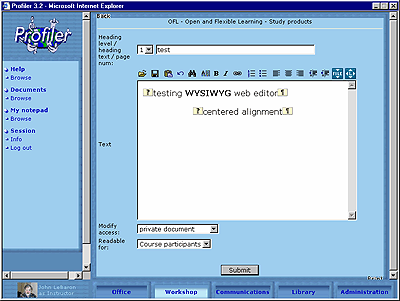
Figure 14. Screen
short of the HTML editing tool.
![]()
Although a distinct effort
was made to create and maintain an open climate of communication in OFL-1999,
the instructional team took the following additional measures to address this
problem in 2000:
![]() Demo
6 instructor's message to one of the students, and the audio file
Demo
6 instructor's message to one of the students, and the audio file
Although the lingua franca
of the course was English, and all formal assignments were expected in English,
the Finnish students were encouraged to chat in their own language, not only
in the Café, but also in the other discussion areas. Moreover, the Finnish
community was assigned its own team communication area for native language communication.
While these strategies precluded the US participants from participation in certain
facets of course dialogue, this small price was well worth the freedom offered
the Finns to communicate, in a small way, with the same degree of fluency and
familiarity as their American counterparts.
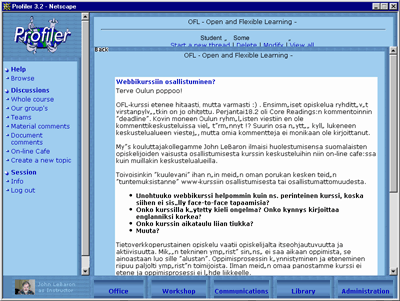
Figure 15. Screen
shot of Finnish discussion area in OFL-2000.
In 1999, the large disparities between the U.S. and Finnish word counts could be explained by the relative difficulty between communicating colloquially in one's native tongue versus the much harder struggle of communicating in a second language. The comparative word counts from OFL-2000, however, suggest that calculated teaching and design tactics can help to reduce such disparities, even though these differences could be attributed to other unexplained variables.
8. Study Limitations and Pointers to Further Research and Action
Knowledge gained from this study cannot necessarily be generalized to other international course settings. Only two iterations of a single course were evaluated. The student sample sizes are small. The study is limited to two countries only, and to rather narrow cultural subgroups within those countries. The analysis reported here has supported several beneficial revisions to OFL-2000, and could similarly contribute to the success of other cross-border initiatives. Future research efforts should be keyed both to the general intentions of the course, and to the unique cultural realities of the participating students. New research should be deeper and more methodologically varied. For example, qualitative interviews with randomly selected students would acutely enrich viewpoints on student perceptions, thereby arming teachers and designers with deeper perspectives for future planning and execution.
After two years teaching Open & Flexible Learning to Finnish and American student audiences, the authors suggest that good software-based language translators, combined with easy-to-use multimedia production and communication tools, would better serve the needs of culturally diverse groups and students with different learning or communication styles. Although it is understood that software-based language translation protocols can never fully decode subtle cultural attributes, there are many dimensions to academic communication that can easily transcend culture.
Simply enrolling in a course with peers from other nations may promote a marginal degree of cross-border awareness, but collaboration beyond the margins demands clear strategy and focused execution. As Jager and Collis (2000) point out, the ongoing sensitivity and skill of the instructor is just as important as the initial course design or the technical attributes of the platform in cross-cultural academic settings. In OFL-1999, collaboration occurred within the Finnish and American student communities, but not significantly across them. Distinct improvements were seen in OFL-2000, but deeper, longer term international cooperation on authentic projects may require large-scale institutional programmatic coalitions that go beyond individual courses.
Having addressed some of
the challenges discovered from OFL-1999, plans are now under discussion
to extend the Finnish-American partnership with other nations. This will complicate
existing challenges and create new ones. The deep satisfaction generated by
increased mutual student interest, sensitivity and cooperation evidenced in
OFL-1999 will make a further attempt to address cross-cultural challenges
in a tri-nation setting well worth the effort.
9. References
Charp, S. Cited in Sherry,
L. (1996). Issues in distance learning. International Journal of Educational
Telecommunications, 1 (4), 337-365.
Davis, N. (1998). Developing telecommunications within European teacher education: progress, plans, and policy. Paper presented at SITE 98: Society for Information Technology & Teacher Education 9th International Conference, Washington, DC, 7 p.
Jager, K. & Collis, B. (2000). Designing a WWW-based Course Support Site for Learners with Different Cultural Backgrounds: Implications for Practice. Paper presented at Ed-Media 2000, World Conference on Educational Multimedia, Hypermedia & Telecommunications, Montreal, Canada, 6 p.
Jenkins, S. (1997). Cultural and Pragmatic Miscues: A Case Study of International Teaching Assistant and Academic Faculty Miscommunication. ERIC: Document No. ED411684, 35 p.
![]()
Lehtonen, J. & Sajavaara,
K. (1985). The silent Finn. In Tannen, D. & Saville-Troike, M. Perspectives
on silence. Norwood, NJ: Abler Publishing. Cited in Iivonen, M., Sonnenwald,
D.H., Parma, M. & Poole-Kober, E. (1998). Analyzing and Understanding Cultural
differences: Experiences from Education in Library and Information Studies.
Paper presented at 64th International Federation of Library Associations
and Institutions (IFLA) General Conference, Amsterdam, Netherlands, 12 p.
Available online WWW: http://www.ifla.org/IV/ifla64/077-155e.htm.
![]() External
links to: IFLA
paper
External
links to: IFLA
paper
![]()
McNabb, M.L. (1995). Perspectives
about education. Available online WWW: http://www.ncrel.org/tandl/change.htm.
![]() External
links to: McNabb,
M. L.
External
links to: McNabb,
M. L.
Mestenhauser, J.A. & Ellingboe, B.J., Ed. (1998). Reforming the higher education curriculum: Internationalizing the campus. Phoenix, AZ: American Council on Education/Oryx Press, 272 p.
Murphy, K. (1991). Patronage and an oral tradition: Influences on attributions of distance learners in a traditional society (a qualitative study). Distance Education, 12 (1), 27-53.
Pulkkinen, J. & Ruotsalainen, M. (2001). Open and flexible learning in an international context: Meeting diverse cultural challenges. In LeBaron, J. & Collier, C., Ed. A place for technology: Technology in its place. San Francisco: Jossey-Bass (in press).
Telg, R.W. (1996). Instructional Design Considerations for Teaching International Audiences via Satellite. International Journal of Instructional Media, 23 (3), 209 - 217.
![]()
Wideman, H. & Owston,
R.D. (1999). Internet-based courses at Atkinson College: An initial assessment.
Centre for the Study of Computers in Education, York University. Available online
WWW:http://www.edu.yorku.ca/csce/tech99-1.html.
![]() External
links to: Wideman,
H. & Owston, R. D.
External
links to: Wideman,
H. & Owston, R. D.
10.
Acknowledgements
OFL was originally
made possible through a Fulbright Scholarship that assigned Professor John LeBaron
to the University of Oulu Faculty of Education in 1998-99. Neither the design
nor the execution of OFL would have been possible without the dedicated
participation of the course tutors. Patrick Scollin, Steven Tello, Karen Hokanson
and Neil Parmenter assisted in the USA. In Finland, Tarja Tervola and Maarit
Saarenkunnas bestowed the necessary leadership in Finland.
********** End of Document
**********
| IMEJ multimedia team member assigned to this paper | Ching-Wan Yip |